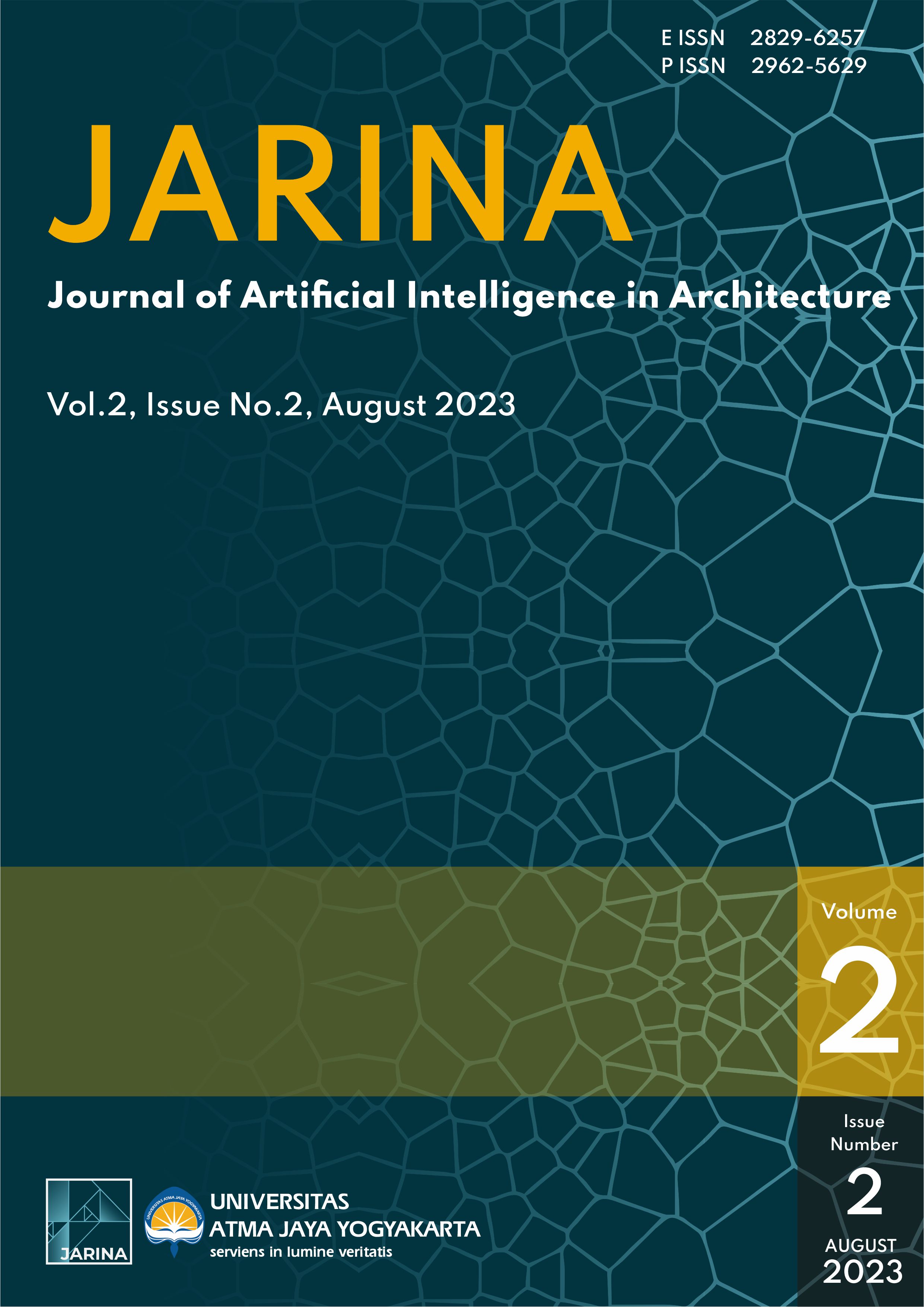A Comparative Study of Natural Lighting Quality in Sharia Housing Based on Daylight Factor Evaluation Using Autodesk Revit
DOI:
https://doi.org/10.24002/jarina.v2i2.6753Keywords:
Daylight factor, Islamic residential concept, Natural lighting quality, Autodesk revitAbstract
The Islamic residential concept is the famous tagline that several real estate developers chose for their housing products today; it attracts customer attention, primarily from the Muslim community. But only some housing products are suitable to all the ideal criteria of the Islamic Residential concept. Excellent Sharia housing must fulfill all Islamic residential concept requirements, including public facilities, open space, and building quality. The strategy of the ideal Islamic housing concept requirement is optimal natural light and ventilation in the entire room. The inner courtyard is one of the solutions to afford this strategy. The types of openings also affect the daylight penetration in a room. Autodesk Revit Simulation evaluates this research about the daylight factor aspect of Islamic housing in Sharia housing. The research method is a qualitative, quantitative, and comparatively mixed method. The minimum requirement of daylight factor for housing is 5%. The study object shows that in the case of Medina Residence 1, it sufficiently offers the most daylight factor affordability in a Sharia housing project. The research hypothesis is to maximize the daylight factor by modifying several types of windows and adding skylight openings to increase the daylight factor of the entire room. Increased wall window ratio and more inner open spaces are the solutions for the minimum size of the building site. In the case of Medina residence 1, the skylight opening can be applied, but the effect is less significant than making more openings facing the open space.
References
M. B. Edrees, KONSEP ARSITEKTUR ISLAMI SEBAGAI SOLUSI DALAM PERANCANGAN ARSITEKTUR, vol. 1. 2012. doi: 10.18860/jia.v1i1.1712.
A. Perdana, “EVALUATION OF PHYSICAL ASPECT OF ISLAMIC RESIDENTIAL CONCEPTS IN THE SHARIA HOUSING PROJECT,” Journal of Architecture & Environment, vol. 19, 2020, doi: http://dx.doi.org/10.12962/j2355262x.v19i2.a6898.
A. Perdana, “Morphological Study of Residential Real Estate Development in Urban Fringe (Case study: Tunggulwulung Urban Village, Municipality of Malang),” in Proceedings of the International Conference of Heritage & Culture in Integrated Rural-Urban Context (HUNIAN 2019), Atlantis Press, 2020, pp. 56–64. doi: 10.2991/aer.k.200729.010.
M. L. Nurrohman, P. Feros, Wahyuning, R. F. Madina, and N. Pratiwi, “Efficient Lighting Design for Multiuse Architecture Studio Classroom using Dialux Evo 9,” IOP Conf Ser Earth Environ Sci, vol. 738, no. 1, p. 012034, 2021, doi: 10.1088/1755-1315/738/1/012034.
G. Yusvita, “Analisis Pencahayaan Ruangan Pada Ruang Kelas Di Universitas Singaperbangsa Karawang Menggunakan Dialux Evo 9.1,” Jurnal Serambi Engineering, vol. 6, no. 3, Aug. 2021, doi: 10.32672/jse.v6i3.3250.
M. E. U. L. Miles Institute, Real estate development : principles and process. Washington, D.C.: Urban Land Institute, 2013.
A. Perdana, “Evaluation of Real Estate Development Process in Sharia Housing Based on The Application of The Ideal Islamic Housing Concept,” IPTEK Journal of Proceedings Series, no. 6, pp. 156–160, 2020, doi: http://dx.doi.org/10.12962/j23546026.y2020i6.9190.
Z. Amalia Bambang Pranggono, “Kajian Penerapan Prinsip-prinsip Perumahan Islami pada Perumahan Muslim Bukit Az Zikra,” Seminar Penelitian Sivitas Akademika Unisba, vol. 3, no. 2, 2017.
M. B. Hermawan, “Explorasi ”Rumah Tinggal Islami” Di Kota Pekanbaru,” Jurnal Arsitektur“Arsitektur Melayu dan Lingkungan,” vol. 1, no. Januari 2014, pp. 1–16, 2014, [Online]. Available: https://www.neliti.com/id/journals/jurnal-arsitektur-melayu-dan-lingkungan
A.-M. Hwaish, Concept of Islamic House ; A Case Study for Early Muslims Traditional House. 2018.
I. M. Khan, “Liveability on Old Dhaka: Evolving residential patterns in Mohallas,” Regionalism in architecture, 1985.
A. Mangione, B. Mattoni, F. Bisegna, D. Iatauro, and M. Zinzi, On the Validity of Daylight Factor for Evaluating the Energy Performance of Building. 2018. doi: 10.1109/EEEIC.2018.8494450.
L. N. W. Groat D., Architectural Research Methods. Wiley, 2013. [Online]. Available: https://books.google.co.id/books?id=sUf5DPJyEqAC
Badan Standardisasi Nasional menjadi, SNI 03-2396-2001 tentang Tata cara perancangan sistem pencahayaan alami pada bangunan gedung. 2001.
S. Kota, J. S. Haberl, M. J. Clayton, and W. Yan, “Building Information Modeling (BIM)-based daylighting simulation and analysis,” Energy Build, vol. 81, pp. 391–403, 2014, doi: https://doi.org/10.1016/j.enbuild.2014.06.043.
K. Guo, Q. Li, L. Zhang, and X. Wu, “BIM-based green building evaluation and optimization: A case study,” J Clean Prod, vol. 320, p. 128824, 2021, doi: https://doi.org/10.1016/j.jclepro.2021.128824.
I. Motawa and K. Carter, “Sustainable BIM-based Evaluation of Buildings,” Procedia Soc Behav Sci, vol. 74, pp. 419–428, 2013, doi: https://doi.org/10.1016/j.sbspro.2013.03.015.
Q. Tushar, M. A. Bhuiyan, G. Zhang, and T. Maqsood, “An integrated approach of BIM-enabled LCA and energy simulation: The optimized solution towards sustainable development,” J Clean Prod, vol. 289, p. 125622, 2021, doi: https://doi.org/10.1016/j.jclepro.2020.125622.
C. Cavalliere, G. Habert, G. R. Dell’Osso, and A. Hollberg, “Continuous BIM-based assessment of embodied environmental impacts throughout the design process,” J Clean Prod, vol. 211, pp. 941–952, 2019, doi: https://doi.org/10.1016/j.jclepro.2018.11.247.
A. Chel, G. N. Tiwari, and A. Chandra, “A model for estimation of daylight factor for skylight: An experimental validation using pyramid shape skylight over vault roof mud-house in New Delhi (India),” Appl Energy, vol. 86, no. 11, pp. 2507–2519, Nov. 2009, doi: 10.1016/j.apenergy.2009.03.004.
A. Chel, G. N. Tiwari, and H. N. Singh, “A modified model for estimation of daylight factor for skylight integrated with dome roof structure of mud-house in New Delhi (India),” Appl Energy, vol. 87, no. 10, pp. 3037–3050, Oct. 2010, doi: 10.1016/J.APENERGY.2010.02.018.
I. Acosta, C. Munoz, M. A. Campano, and J. Navarro, “Analysis of daylight factors and energy saving allowed by windows under overcast sky conditions,” Renew energy, vol. 77, no. 1, pp. 194–207, May 2015, doi: 10.1016/J.RENENE.2014.12.017.
A. A. Ahadi, M. R. Saghafi, and M. Tahbaz, “The study of effective factors in daylight performance of light-wells with dynamic daylight metrics in residential buildings,” Solar Energy, vol. 155, pp. 679–697, Oct. 2017, doi: 10.1016/J.SOLENER.2017.07.005.
Y. Bian and Y. Ma, “Analysis of daylight metrics of side-lit room in Canton, south China: A comparison between daylight autonomy and daylight factor,” Energy Build, vol. 138, pp. 347–354, Mar. 2017, doi: 10.1016/J.ENBUILD.2016.12.059.
A. Ahmad et al., “Dynamic analysis of daylight factor, thermal comfort and energy performance under clear sky conditions for building: An experimental validation,” Mater Sci Energy Technol, vol. 5, pp. 52–65, Jan. 2022, doi: 10.1016/J.MSET.2021.11.003.
N. T. Pitasari, P. Setijanti, and S. Cahyadini, “Islamic Residential Concept on Sharia Housing Consumers’ Satisfaction,” nternational Journal of Multidisciplinary Research and Publications (IJMRAP), vol. 4, no. 7, pp. 11–15, 2021.

Downloads
Published
How to Cite
Issue
Section
License
Copyright (c) 2023 Angga Perdana

This work is licensed under a Creative Commons Attribution 4.0 International License.
Authors who publish with this journal agree to the following terms:
1.Authors retain copyright and grant the journal right of first publication with the work simultaneously licensed under a Creative Commons that allows others to share the work with an acknowledgement of the work's authorship and initial publication in this journal.
2.Authors are able to enter into separate, additional contractual arrangements for the non-exclusive distribution of the journal's published version of the work (e.g., post it to an institutional repository or publish it in a book), with an acknowledgement of its initial publication in this journal.
3.Authors are permitted and encouraged to post their work online (e.g., in institutional repositories or on their website) prior to and during the submission process, as it can lead to productive exchanges, as well as earlier and greater citation of published work (See The Effect of Open Access).
















